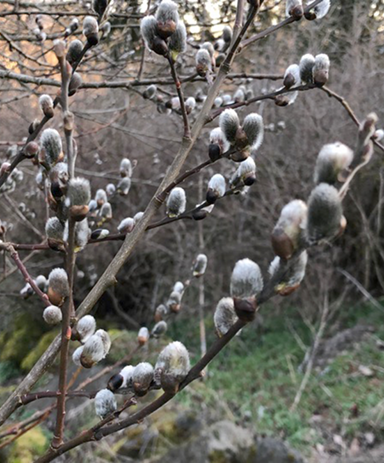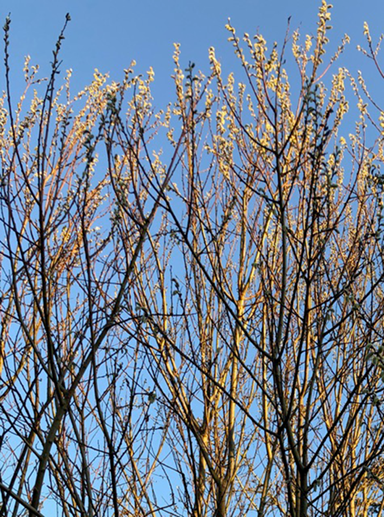Bend like a willow

By Susan Mates

Willows are ecological heroes when it comes to providing habitat and support for wildlife year round. They help reestablish vegetation, especially along riverbanks and flooded or burned areas. And they are a vital source of food for all kinds of wildlife, in particular as a host plant for many, many types of caterpillars. You may not be the biggest fan of caterpillars, but birds are.
Willow trees are classic, graceful trees.You may be most familiar with the weeping willow (Salix babylonica) that comes from China, but there are many locally native species of willow(Salix sp.) in thePacific Northwest. Exact identification is difficult because their characteristics can be different even on the same plant.
One thing all willows have in common is that they like to grow along streams. Willows develop a dense fibrous root system that searches out water. They grow quickly and root easily, even when only a branch is jammed into the ground. The flexible stems of willows bend to shade streams, slow floods, filter sediment, and improve water quality.

Willow leaves are usually long, thin and lance-shaped, yellow-green on top and white below. The twigs are yellow to green, brightening the winter landscape and providing structure and cover for nesting birds, especially the goldfinches that prefer willows.
In late winter look for willows’ distinctive catkins. These fur-like “pussy willows” are keeping the reproductive parts of the plant warm. Some birds, especially hummingbirds, use that fuzzy softness to line their nests.
In any willow thicket, one tree may be fully flowered out while its neighbor still has closed buds. That means the blooming season stretches from late February well into April, making them critical first-of-the-season nectar sources for bees and other pollinators. The protein-rich insects then provide dinner for songbirds and their babies. Without this early food source, queen bumblebees would need to fly longer distances to find nectar, using up valuable food reserves.
This time of year, blooming willows are among the best places to look for small warblers and other birds. As a boon for birders, the relatively short willow thickets make catching a glimpse of songbirds easier than in taller forests.

Come April, winds scatter hundreds of tiny willow seeds, whose fine hairs help them fly through the air. The seeds germinate quickly, even 12-24 hours later. The seeds contain chlorophyll and are raring to photosynthesize—all they need is moisture and light!
Many species of butterflies lay their eggs on the tips of willow leaves where the tiny caterpillars hatch and feed. In fall the caterpillar rolls itself in a leaf and, as the leaves wither and curl, the caterpillar drops with the leaf. There it stays until spring, nestled in the leaf litter which is full of seeds and other overwintering insects—an excellent food source for foraging birds. When willow leaves begin budding again, the uneaten caterpillars climb back up the bush and feed on new growth before becoming a chrysalis.
For many wildlife species, willows provide food and cover. Wood-boring beetle larvae and other insects love soft willow wood and so do the woodpeckers that search for them. Delicate young willow twigs provide important forage for mammals such as beaver, elk and deer during the winter. Watch for signs that beavers have been near! Willows provide a little something for everyone.
Join us at Treekeepers of Washington County as we work to protect and advocate for willows and other mature trees.





